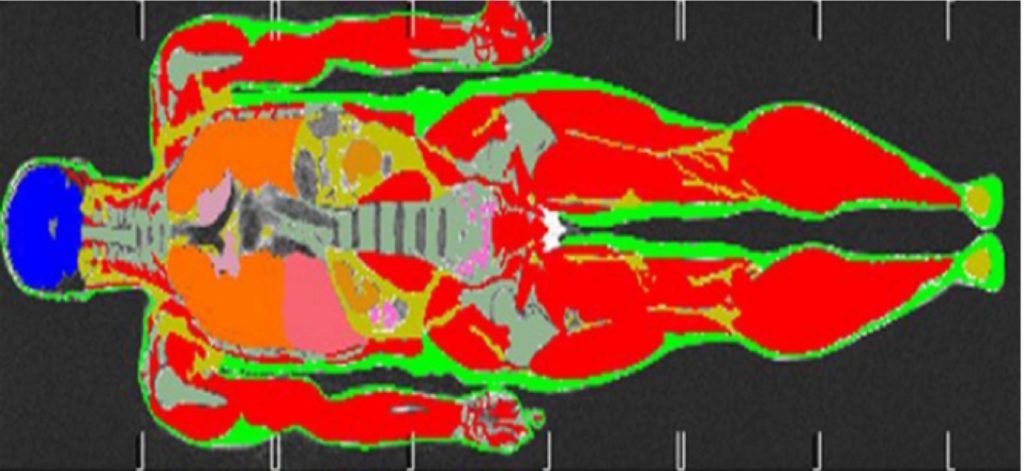DIET: Thin People May Be Fat on the Inside, Doctors Warn; Exercise Key, Rather Than Dieting
This undated MRI scan image released by Imperial College, London, provides a detailed look at where fat is stored internally in the human body. The image is of an average-sized man who is 1.9 meters tall, weighs 79 kilograms and has a normal index of 21.7. Internal fat is shown as yellow, external fat is green and muscles are red. Some doctors now think that the internal fat surrounding vital organs like the heart, liver or pancreas – invisible to the naked eye – could be as dangerous as the more obvious external fat that bulges underneath the skin. (AP Photo, Imperial College, London, HO)
The Associated Press
LONDON May 10, 2007 (AP)
If it really is what’s on the inside that counts, then a lot of thin people might be in trouble. Some doctors now think that the internal fat surrounding vital organs like the heart, liver or pancreas invisible to the naked eye could be as dangerous as the more obvious external fat that bulges underneath the skin.
“Being thin doesn’t automatically mean you’re not fat,” said Dr. Jimmy Bell, a professor of molecular imaging at Imperial College, London. Since 1994, Bell and his team have scanned nearly 800 people with MRI machines to create “fat maps” showing where people store fat.
According to the data, people who maintain their weight through diet rather than exercise are likely to have major deposits of internal fat, even if they are otherwise slim. “The whole concept of being fat needs to be redefined,” said Bell, whose research is funded by Britain’s Medical Research Council.
Without a clear warning signal like a rounder middle doctors worry that thin people may be lulled into falsely assuming that because they’re not overweight, they’re healthy.
“Just because someone is lean doesn’t make them immune to diabetes or other risk factors for heart disease,” said Dr. Louis Teichholz, chief of cardiology at Hackensack Hospital in New Jersey, who was not involved in Bell’s research.
Even people with normal Body Mass Index scores a standard obesity measure that divides your weight by the square of your height can have surprising levels of fat deposits inside.
Of the women scanned by Bell and his colleagues, as many as 45 percent of those with normal BMI scores (20 to 25) actually had excessive levels of internal fat. Among men, the percentage was nearly 60 percent.
Relating the news to what Bell calls “TOFIs” people who are “thin outside, fat inside” is rarely uneventful. “The thinner people are, the bigger the surprise,” he said, adding the researchers even found TOFIs among people who are professional models.
According to Bell, people who are fat on the inside are essentially on the threshold of being obese. They eat too many fatty, sugary foods and exercise too little to work it off but they are not eating enough to actually be fat. Scientists believe we naturally accumulate fat around the belly first, but at some point, the body may start storing it elsewhere.
Still, most experts believe that being of normal weight is an indicator of good health, and that BMI is a reliable measurement. “BMI won’t give you the exact indication of where fat is, but it’s a useful clinical tool,” said Dr. Toni Steer, a nutritionist at Britain’s Medical Research Council.
Doctors are unsure about the exact dangers of internal fat, but some suspect it contributes to the risk of heart disease and diabetes. They theorize that internal fat disrupts the body’s communication systems. The fat enveloping internal organs might be sending the body mistaken chemical signals to store fat inside organs like the liver or pancreas. This could ultimately lead to insulin resistance, type 2 diabetes, or heart disease.
Experts have long known that fat, active people can be healthier than their skinny, inactive counterparts. “Normal-weight persons who are sedentary and unfit are at much higher risk for mortality than obese persons who are active and fit,” said Dr. Steven Blair, an obesity expert at the University of South Carolina.
For example, despite their ripples of fat, super-sized Sumo wrestlers probably have a better metabolic profile than some of their slim, sedentary spectators, Bell said. That’s because the wrestlers’ fat is primarily stored under the skin, not streaking throughout their vital organs and muscles.
The good news is that internal fat can be easily burned off through exercise or even by improving your diet. “Even if you don’t see it on your bathroom scale, caloric restriction and physical exercise have an aggressive effect on visceral fat,” said Dr. Bob Ross, an obesity expert at Queen’s University in Canada. Because many factors contribute to heart disease, Teichholz says it’s difficult to determine the precise danger of internal fat though it certainly doesn’t help.
“Obesity is a risk factor, but it’s lower down on the totem pole of risk factors,” he said, explaining that whether or not people smoke, their family histories and blood pressure and cholesterol rates are more important determinants than both external and internal fat.
When it comes to being fit, experts say there is no short-cut. “If you just want to look thin, then maybe dieting is enough,” Bell said. “But if you want to actually be healthy, then exercise has to be an important component of your lifestyle.”










